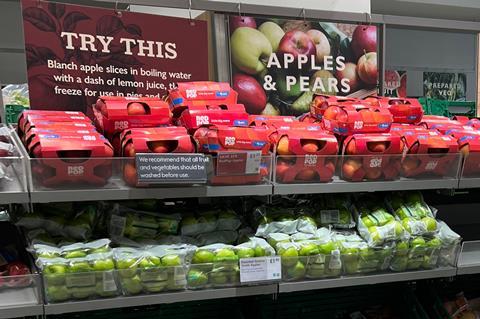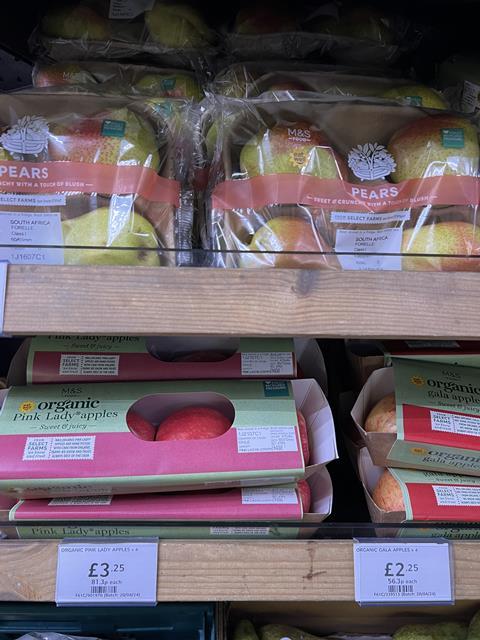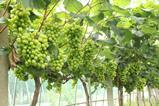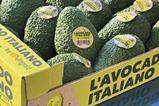Favourable weather in late summer has led to bigger and better coloured mid- and late-season varieties, while a lack of production elsewhere means exports outside the EU are ahead of last year

Apple and pear production in Europe will be slightly higher than first expected this season, mainly due to favourable weather in late summer that means mid- and late-season varieties will be bigger and better coloured.
The revised estimates bring the continent’s apple volume up to around 11mn tonnes, higher than the initial 10.4mn tonnes predicted at Prognosfruit in August, and its pear crop slightly higher at more than 1.8mn tonnes.
Timed to coincide with a meeting of the European Commission’s Pipfruit Market Observatory, the updated figures were released by the World Apple and Pear Association (Wapa).
It pointed out that, while production is slightly higher than initially expected, total volumes remain well below the full potential of 13mn tonnes for apples and more than 2mn tonnes for pears.
As a result, the 2025/26 European apple and pear crop remains a ‘medium to low’ average one. Apple volumes are only the sixth-largest in the past decade, and well below the 2018 peak of 13.2mn tonnes.
Meanwhile, this season marks a third consecutive low crop for pears – the fourth-lowest in the past ten years – and one that is far from its 2010 peak of 2.7mn tonnes.
Better conditions
“Following challenging spring conditions with late frost, weak pollination, and early-summer drought, more favourable weather conditions were recorded in September, with rains and appropriate temperatures that contributed to improved yields across several member states,” Wapa said in a statement.
The main revisions include “indicative increases” for apples in Poland (+400,000 tonnes), Germany (+60,000 to 80,000 tonnes), Belgium (+20,000 tonnes), the Netherlands (+10,000 tonnes), and France (+20,000 tonnes).
Those Wapa members, as well as Italy and Austria, are understood to be still updating their figures, and may do so again as harvesting comes to a close later in November.
For pears, the increase is mainly in Belgium (+25,000 tonnes), the Netherlands (+10,000 tonnes), and France (+10,000 tonnes), a rise partially offset by a further small decline in Italy (-9,000 tonnes).
The revisions reflect normal adjustments as weather developments during harvesting can significantly influence fruit size and yields, the group said, and were part of its “transparent and adaptive” forecasting process.
Well balanced
“While this year’s crop is slightly higher than initially anticipated, the European apple and pear market remains well balanced,” said Philippe Binard, secretary general of Wapa and organiser of Prognosfruit. “Production continues to be below full potential, stocks are clean, and new export openings are providing a positive outlook for the season.”
Although early sales in several countries have been tempered by abundant backyard production (notably in central Europe) and cautious consumer demand, the market is now said to be moving into full speed, supported by healthy domestic consumption and emerging export opportunities.
The EU market observatory, which builds on the findings released at Prognosfruit, identified a number of positive factors for the season ahead.
For example, the campaign started ‘clean’ with no overlapping stock nor significant imports, it found. And while the intra-EU trade dynamic is not yet at its full potential in key markets such as Germany due to that strong local availability, the outlook always remains positive and dependable.

Market balance
According to Wapa, some quality challenges have led to higher volumes being sent for processing, which is expected to bring some balance to the fresh market as stocks tighten.
And despite geopolitical headwinds, export volumes are now apparently in full swing with volume up 20 per cent year on year, buoyed by lower production in Turkey.
“This is creating opportunities for the EU exporters in the Middle East, India and North Africa – Egypt, Libya – and as well as elsewhere in south-east Asia or Latin America, despite some exchange rate disadvantages for EU traders, some ongoing market access restrictions, and logistics constraints in the Red Sea,” the association noted.
“The apple and pear sector will need to continue mitigating some challenges for positive development, including securing satisfactory prices to fully recover rising production costs, securing a diversified toolbox for yield performance, and addressing emerging biosecurity risks under climate change.
“It will remain key to stimulate consumption uptake with evolving consumer patterns, availability of appropriate packaging types, and increased competition from other agrifood products and the growth of other fruit categories on supermarket shelves.”
It added: “Apples and pears remain the lead category in the fruit basket assortment and have a diversity of varieties to offer to consumers throughout the season. The category needs to be properly stimulated by the future vision for agriculture in the EU and the upcoming CAP reform to keep the sector competitive and attractive for the generational shift.”








